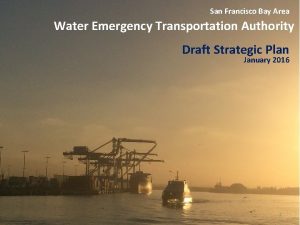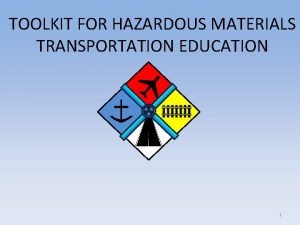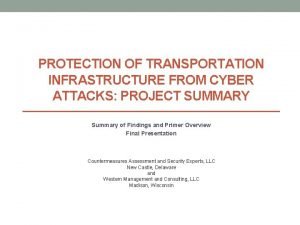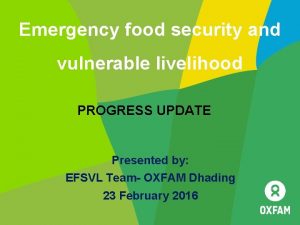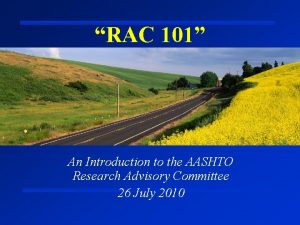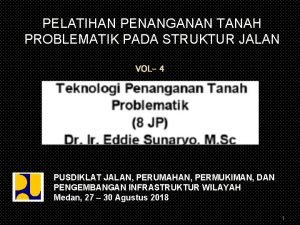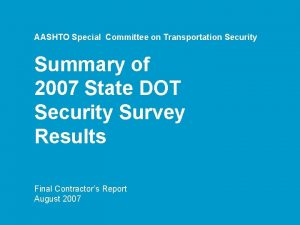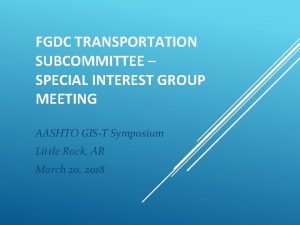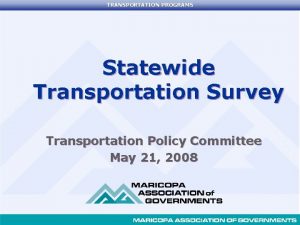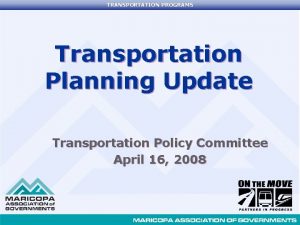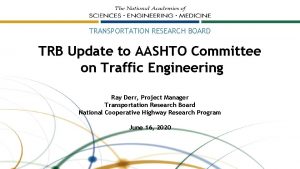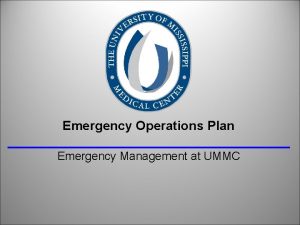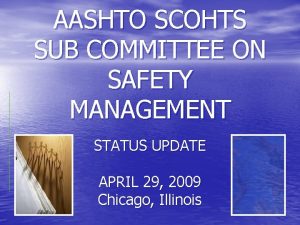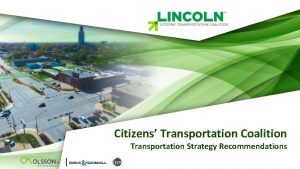AASHTO Special Committee on Transportation Security Emergency Management



















- Slides: 19

AASHTO Special Committee on Transportation Security & Emergency Management Summary of 2010 State DOT Security/Emergency Management Survey Results Final Contractor’s Report May 2011

Study Requested By: AASHTO Special Committee on Transportation Security & Emergency Management Study Prepared By: Joe Crossett, High Street Consulting Group Under Contract NCHRP 20 -59 (29) Acknowledgments This study was requested by the American Association of State Highway and Transportation Officials (AASHTO), and was conducted as part of National Cooperative Highway Research Program (NCHRP) Project 20 -59(29). The NCHRP is supported by annual voluntary contributions from the state Departments of Transportation. Project 20 -59 is intended to fund quick response studies on behalf of the AASHTO Special Committee on Transportation Security and Emergency Management. The work was guided by a task group that included Chief Joseph C. Bober, Mr. John M. Contestabile, Mr. David S. Ekern, Mr. Randall H. Iwasaki, Mr. Mark Krentz, Mr. Herby Gerard Lissade, Ms. Eileen M. Phifer, Mr. Bryan D. Smith, Mr. Jeffrey L. Western, Mr. Robert A. Younie, Mr. Steven L. Ernst, Mr. Ernesto L. Acosta, Mr. William Brownlow, Mr. Mark S. Bush, Ms. Georgia M. “Gia” Harrigan, Mr. Vincent P. Pearce, LTC Gregory A. Pickell, Mr. Charles Sikoff, Ms. Joedy W. Cambridge, Ms. Sheila Rimal Duwadi, Mr. Dan Ferezan, Ms. Laurel J. “Laurie” Radow, and Mr. Chuck Runyon (chair). The project was managed by Stephan. A. Parker, CRP Senior Program Officer. The report was prepared by Joe Crossett of High Street Consulting, LLC. Disclaimer The opinions and conclusions expressed or implied are those of the research agency that performed the research and are not necessarily those of the Transportation Research Board or its sponsors. This report has not been reviewed or accepted by the Transportation Research Board's Executive Committee or the Governing Board of the National Research Council.

Responding DOTs • • • Alabama California Florida Idaho Iowa Kansas Maryland Michigan Mississippi Missouri • • • Nevada North Dakota Ohio Pennsylvania Tennessee Vermont Washington West Virginia Wisconsin 2

Response Rate Comparison 2007 Survey Did not Respond 31% (16) 2010 Survey Responded 37% (19) Responded 69% (36) Did not Respond 63% (33) 3

Top All-Hazards Security Priorities (Each respondent asked to list up three priorities; chart shows share of respondents that mentioned the most commonly cited priorities) All-Hazards Emergency Prevention, Preparedness, Mitigation, Response & Recovery 39% 58% 37% Emergency Transportation Operations (New 2010) 26% Securing Critical Infrastructure Communications & Information Exchange 11% Continuity of Operations 11% 97% 26% 21% 2010 2007 21% Other Safety of Employees (New 2010) 16% Employee Training & Awareness 16% 11% Evacuation Planning 0% *Author developed categories to summarize DOTs’ individual responses 20% 53% 36% 22% 40% 60% 80% 100% 4

Background of DOT Leader for Emergency Management/Security Issues Don't Know 5% (1) Transportation 32% (6) Both 42% (8) Emergency Management/Sec urity 21% (4) 5

Agency-wide ‘All Hazards’ Emergency Management Plan in Place or Underway: No 5% (1) Mass Transit Integrated into Plan: No 47% (9) 2010 Yes/Under way 95% (18) No 19% (7) 2007 Yes/Unde rway 81% (29) No 53% (19) Yes 53% (10) Yes 47% (17) Year Emergency Management Plan last exercised: 2009/10 (average of 12 responses) 6

Coordination of Emergency Management Plans Coord. with Nat. Incident Mgmt. Sys. 0% 50% 100% 95% 94% 0% 100% Coordinated with regional plans 84% 66% 0% 50% Coordinated with statewide plans 50% 100% Coordinated with local govt. plans 68% 2010 69% 2007 100% 0% 20% 40% 60% 80% 100% 7

Awareness about National Incident Management System Compliance Assistance Support Tool Not aware of NIMSCAST – 22% (4) Aware of NIMSCAST and use it – 61% (11) Aware of NIMSCAST but do not use it 17% (3) 8

Infrastructure Security Plan Don't Know 5% (1) Yes 28% (5) No 67% (12) Year Infrastructure Security Plan last exercised: 2008 (average of 3 responses) 9

Continuity of Operations Plan (COOP Plan) No 5% (1) Yes 95% (18) Year COOP last exercised: 2009 (average of 14 responses) 10

Frequency of Collaboration with Neighbor States Rarely 5% (1) Frequently 53% (10) Sometimes 42% (8) 11

Internal Radio Communications Interoperability Capabilities DOT'S radio communications interoperability needs SOMEWHAT met 10% (2) DOT'S radio communications interoperability needs ALL met 16% (3) DOT'S radio communications interoperability needs MOSTLY met 74% (14) 12

Training Priorities (Share of respondents who indicated “more training needed” in key focus areas) Infrastructure Design for Security 58% 67% 61% Integrating Emergency Management and Security in Planning 56% National Emergency Communications Plan (New 2010) Evacuation Planning 56% 31% 44% Detecting, Deterring, & Mitigating Security Threats Interagency Radio Communications (New 2010) 39% Cyber security (New 2010) 39% 2010 2007 28% Assessing Transportation Network Vulnerabilities 53% 56% 22% General Interagency Communication (New 2010) General Emergency Management & Security Awareness 17% Emergency Transportation Operations (New 2010) 17% All Hazards Emergency Preparedness & Response 17% 0% 10% 20% 31% 30% 40% 50% 60% 70% 80% 13

Primary Training Delivery Method Classroom-based (transportation agency personnel only) Mix of classroom 11% (2) and online (personnel from multiple agencies) 21% (4) Classroom-based (personnel from multiple agencies) 5% (1) Mix of classroom and online (transportation agency personnel only) 63% (12) 14

Completion of Incident Command System Training 19 19 19 Number of States Completing Training 17 17 16 15 10 5 0 ICS 100 ICS 200 ICS 300 ICS 400 ICS 700 ICS 800 15

Completion of ICS Training by Staff Type ICS 800 28% 44% 33% 56% 78% ICS 700 ICS 400 ICS 300 ICS 200 ICS 100 61% 22% 28% 22% 83% 94% 44% Staff Mid-Level Managers 44% 50% Senior Managers Executive Leaders 67% 78% 39% 61% 89% 94% 83% 0% 20% 40% 60% 80% 100% Share of Agencies Indicating Appropriate Staff are ICS Trained 16

Preferred Capacity Building Approaches (Number of respondents that report they are “very likely to use” general capacity building mechanisms described below) 84% Print/electronic training materials 61% 63% Conferences & peer exchanges 44% 53% Web-based seminars 2010 31% 2007 47% 42% Web-based information clearinghouse 37% Exercises & workshops 67% 0% 10% 20% 30% 40% 50% 60% 70% 80% 90% 17

Awareness about Homeland Security Exercise and Evaluation Program (HSEEP) Not aware of HSEEP – 10% (2) Aware of HSEEP and use it – 53% (10) Aware of HSEEP but do not use it 37% (7) 18
 Privatesecurity
Privatesecurity Water emergency transportation authority
Water emergency transportation authority Where's my ride logisticare texas
Where's my ride logisticare texas Transportation security
Transportation security Ics cyber security for transportation
Ics cyber security for transportation Qut security contact number for emergencies
Qut security contact number for emergencies Qut security emergency extension number
Qut security emergency extension number Emergency food security and vulnerable livelihoods
Emergency food security and vulnerable livelihoods Fifa 2022 background
Fifa 2022 background Clasificacion aashto
Clasificacion aashto Flexible pavement design equation
Flexible pavement design equation Rac 101
Rac 101 Tabel klasifikasi tanah aashto
Tabel klasifikasi tanah aashto Clasificacion aashto y sucs
Clasificacion aashto y sucs Nuclear density tester
Nuclear density tester Thickness of flexible pavement
Thickness of flexible pavement Aashto classification
Aashto classification Aashto classification
Aashto classification Lapis pondasi agregat kelas b
Lapis pondasi agregat kelas b Clasificacion aashto
Clasificacion aashto

